A simple guide through the what and why of it.
Mobile applications have become the go-to place to find solutions for existing problems. In a market filled with big old firms and newbies alike, mobile apps need to have an edge over the competitors to see daylight. Picking the right features defines how an app would reach the customers. The perfect balance between basic features and innovation, without overloading a customer is required to achieve this. Building a mobile app is a complex process and the fruits at the end of it should make the hustle worthy.
Business strategies are decided even before beginning the process. According to Statistia, the global retention rate for mobile apps came down to 32% in 2019 and 1/4th of the apps was used only once after being downloaded. The staggering numbers could be a result of several reasons but one of the main reasons is the lack of appropriate features that cater to the exact needs of the customers. Paid downloads and in-app advertising alone are expected to generate 9935 billion US dollars by 2023. The monumental numbers could only prove the value of mobile apps in today’s world and the competition that’s growing like never before.
Mobile app companies in Toronto - a leading tribe
Canada is one of the top countries contributing to the app development world. Several of the top mobile app companies have their base in Toronto. RootQuotient, one of the top mobile app development companies in Toronto, has been sought after by several big and small brands alike. It has been selected as the leader in mobile app development by Clutch.
How mobile applications in Toronto find their way into the market
Here are some of the tips to stay on top of the game while choosing the features of a mobile app:
1. Identify the purpose
A good amount of research walks a business through the current and future markets. A product should be derived with a clear purpose in mind and that should be the first step to determine the features. A Product Requirements Document (PRD) is one way to approach this step. The right objectives are set, and what would be considered success is also determined at this step.
This fastidious approach makes it simpler to identify each feature that will assist in achieving the objectives. When the ‘why’ is defined, the ‘what’ and ‘how’ start taking shape on their own. This can be considered the heart of a product as everything else follows the direction determined by the PRD.
2. Prioritize the features
Purpose leads to identifying what the app should do. For each purpose and feature, the importance of them must be listed and the most important ones must be secured first. The PRD is used as a guideline and the most obvious ones are recognized and which ones should feature in the app immediately.
This prioritization also helps in saving some of the features for later updates and keeping the customer engaged with the app without being bored with the same features for a long time. Priorities are also influenced by the tools and technologies required to develop the features.
3. Adequate user experience
Any mobile app should cater to the needs of each and every customer. Simplicity and user-friendly experience are the main aspects to be considered while designing features for an app. The design layout should make available the basic features as soon as they open the app.
Spending more time on the app trying to figure out how to use it may turn frustrating for a user and they may even abandon the app after the first time. For instance, an app assisting an old person should not require too many steps for signing up or logging in. The features on the home page should be clearly visible and simple to use.
4. Usable on multiple platforms
Cross platform apps are beneficial for both the business and the users. They save time, effort and money while building the app and the users need not worry about their mobile software to download the app. Some of the most commonly used cross platform frameworks are React Native, Native Script, PhoneGap, etc.
According to Statistia, roughly one-third of mobile app developers use cross platform frameworks with React Native being preferred by 42%of them. Availability for everyone during the launch is a major way to attract more customers.
5. Regular updates
Constant updates guarantee customer retention and user engagement. This also benefits the app by pushing to expand further and correct previous errors frequently. Renewed features and content that are useful for the users should be provided at regular intervals.
The most successful apps release anywhere between 1 and 4 updates, major and minor, per month. It is ideal to plan for 2 to 4 updates per month and release them based on customer feedback and reviews.
What app developers in Toronto prefer?
Although there are innumerable app developers in Toronto, the above steps are the most prescribed, tried and tested ways to include features in a mobile app, according to experts in the city. To summarize them all,
- An app should show its presence as both a problem-solving resource and an assistant in daily life.
- Build an app with the user in mind.
- Know your purpose and list the features in the order of their importance.
- Update and expand constantly yet carefully. It could make or break the app’s future.
A mobile app also requires the developers to choose the right technology stack. Assuring security, offline access, performance monitoring, adding new features, etc., are some of the next steps to think of while continuing to serve users with a mobile app. The firms should also find different ways to acquire customer feedback for continuous improvement and development. Contact us to help you with development of your mobile app as per your wish.
